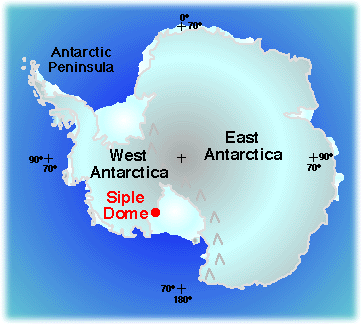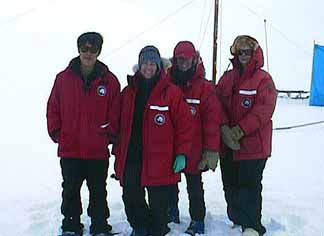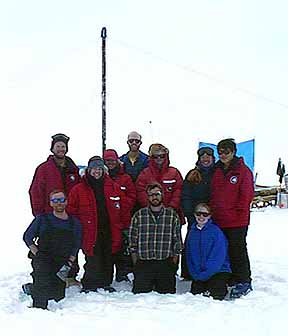
|


E. Shackleton joined Sandy's research team at Siple Dome.  Hi from Sandy Shutey! I currently teach at Butte High School in Butte, Montana. I teach physics to senior students in my school of approximatley 1700 students. Our high school houses the ninth through twelfth grades with students being bussed to the school from all over the county of about 30,000 people. I live in Butte, which is settled in a valley about 5800 feet above sea level. The valley is surrounded by mountains that are green with pine trees in the fall,spring and summer and white with snow the rest of the time. Our weather is usually cold during the winter and warm during the summer - warm meaning with temperatures running in the seventies and maybe eighties. Montana is a state that has beautiful mountain and clear streams that run in three directions due to the divides in the mountains. Our streams flow to the Pacific, Atlantic, and the Gulf of Mexico. My students enjoy fishing, hunting, and hiking during the warm weather with skiing and other snow related sports during the winter. Butte is home of a large pit that contains a lake consisting of sulfuric acid which is a result of an open pit copper mine that is now closed. We still have some mining going on in the town but it is trying to change to a service community and is inviting manufacturing companies to open their businesses there. We have a local college, Montana Tech of the University of Montana, that speciallizes in engineering courses where most of our college bound students end up going to school.  Near-Surface Processes Affecting Gas Exchange: West Antarctic Ice Sheet Investigator: Mary R Albert, USACRREL I was part of a research team working at Siple Dome, Antarctica, collecting and analyzing ice cores. This work was part of the WAISCORES initiative. Ice cores offer important clues to Earth's past climate. As snow parcticles land, they trap pockets of air between them. These air pockets get buried as more snow accumulates on top. Eventually they are isolated from exchange with the atmosphere, thus preserving a sample of air from a time gone past. As the snow is progressively buried, it is becomes firn (compacted, granular snow) and then ice. Ice sheets can be a few kilometers thick and can contain ice that fell as snow over 100,000 years ago. By drilling through the ice and collecting a core, we sample the record of Earth's changing atmosphere. Ice Cores: Windows to the Past What's Under There? Under the Ice: Imaging Glacier Bases with Sound Fluffy Snow to Glacier Ice  Sandra assisted with the collection of ice core data at a remote field station, Siple Station, during her field season in Antarctica.  Dr. Albert's "firn" team on the WAISCORES project at Siple Dome. Left to right are Joey Tsai, Dr. Albert, Nancy Cloud and Sandy. The project I worked on examined how various chemical components of the atmosphere become a part of the snow and firn. Some atmospheric components are more active chemically than others. This difference in activity causes the various components to be incorporated into and move through the snow at different rates. We also are looking at how energy from sunlight hitting the snow and firn affects the behavior of chemical species. We need to know just how the various chemical species behave so that we can make the best possible interpretation of ice core data. One issue scientists need to deal with is what length of time is represented by an air bubble trapped in the ice. Because it takes a while for these pockets of air to be sealed off from the atmosphere by accumulation of snow above them, data from a chemical species that is known to not move far in snow and firn can be used to create a much more detailed picture of past atmospheres than data from chemical species that commonly migrate long distances.  People working at the Clean Air Site - about 6 kilometers from Siple Dome. Kneeling from left to right - Earl (head driller), Brent Matson (University of Arizona) and Hannah Thomas (Girl Scout from Massachusetts). Standing from left to right - Ken Jessen (driller), Dr. Mary Albert (CRREL in New Hampshire), Nancy Cloud (project assistant for Dr. Albert), Joe McConnell (University of Arizona), Rhonda Ecker (Driller), and Joey Tsai (NSF student from Florida). The old air trapped in isolated pockets in the ice allows us to estimate past climate properties such as temperature, general atmospheric circulation patterns, and what the concentrations of greenhouse gases were when the snow fell. Understanding how climate has changed in the past will help us predict the changes that may take place in the future.  November 1997
|
